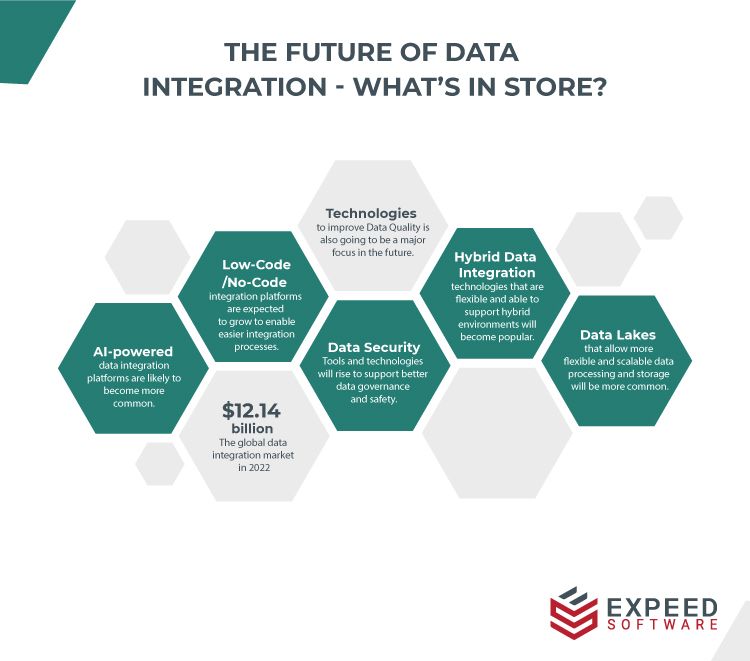Data integration has become an increasingly important topic for organizations in the modern digital landscape. With the proliferation of big data, organizations have access to more data than ever. However, this data is often scattered across different systems and formats, making it difficult to access and analyze. This is where data integration technologies come into play.
Data integration technologies help organizations combine data from various sources and make it more usable. By combining data from different systems and formats, these technologies help create a more comprehensive view of all data collected, thereby enabling faster decision-making capacities for businesses.
Organizations today can choose from different approaches to data integration. The most common are:
- ETL (extract, transform, load): involves extracting data from its source, transforming it into a usable format, and then loading it into a target system.
- ELT (extract, load, transform): involves extracting data from its source, loading it into a target system, then transforming it into a usable format. It differs from traditional ETL as transformation takes place after data is loaded into the target system. This allows for real-time data integration and more flexible data processing.
- Data Federation: involves creating a virtual view of data from multiple sources without physically storing it in a single location. In this method of data integration, data is consolidated from multiple independent sources into a single virtual data store without moving or copying the data. As organizations generate and collect more data from various sources, such as social media, IoT devices, and web data, it becomes increasingly difficult to manage and make use of this data. Data federation allows organizations to access and query data from multiple sources as if it were stored in a single location, making it easier to analyze and make use of the data despite the volume and variety of data sources.
This article will delve deeper into the evolution of data integration technologies. We will also discuss the current trends and challenges in data integration, as well as its future and changing landscape.
The Evolution of Data Integration Technologies
The history of data integration can be traced back to the early days of computing, when data was often moved from one system to another using physical media, such as tapes or floppy disks. This manual and time-consuming process involved copying data from one system and then manually re-entering it into another.
One of the key milestones in the evolution of data integration was the development of ETL tools in the 1980s. ETL tools made it much easier for organizations to combine data from different sources and made it possible to perform data integration tasks more quickly and accurately.
The rise of the internet and cloud computing in the late 1990s and early 2000s had a significant impact on data integration. Accessing and sharing data from anywhere made it easier for organizations to combine data from multiple sources. It also paved the way for the development of cloud-based data integration platforms.
In recent years, there has been a shift towards self-service data integration tools, which empower business users to perform data integration tasks without needing IT intervention. These tools are often designed to be user-friendly and easy to use, making it possible for non-technical users to perform data integration tasks.
You can also notice a growing trend towards data integration as a service, which allows organizations to outsource their data integration needs to a third-party provider. This model offers many benefits, including reduced IT overhead, faster deployment, and access to expert resources. Platforms like Amazon Web Services (AWS), Glue DataBrew, Google Cloud Data Integration, Stitch Cloud Data Integration, and Fivetran Cloud Data Integration are some of the popular platforms that offer data integration as a service.
Overall, the evolution of data integration technologies has been driven by the increasing use of various cloud applications and the need for organizations to access and analyze data from various sources, as well as technological advances that have made it easier to do so.
Current Trends in Data Integration
- Need For Real-Time Integration: One of the current trends in this space is the increasing need for real-time data integration. With the proliferation of big data, organizations are generating and collecting data at an unprecedented rate. To make the most of this data, it is important to be sure it can be accessed and analyzed in real-time. This requires data integration technologies that can handle high volumes of data and process it quickly.
For example, streaming data integration technologies allow organizations to process and analyze data in real time as it is generated. This enables organizations to make timely and informed decisions based on the most up-to-date data. Streaming data integration technologies like Google Cloud Dataflow, Microsoft Azure, and Stream Analytics are used by organizations today to capitalize on real-time data and support faster decision-making.
- Increasing Volume and Variety of Data Sources: Another trend is the increasing volume and variety of data sources. Organizations generate and collect data from various sources, including social media, sensors, and IoT devices. This makes it more challenging to integrate data from different sources and formats and requires data integration technologies that are flexible and scalable. Data integration platforms built on cloud computing architectures are well-suited to meet this challenge, as they can scale up to handle large volumes of data or scale down when needed.
Additionally, data integration platforms that support various data formats and sources can help organizations integrate data from different sources more easily. Cloud computing platforms that support multiple data formats and sources include Talend Cloud Data Integration, Informatica Cloud, and MuleSoft Anypoint Platform CloudHub.
- The Rise of Self-Service Data Integration: As mentioned earlier, there has been a steady rise in demand for self-service data integration tools, that empower business users to perform integration tasks without IT intervention. These tools are often designed to be user-friendly and easy to use, making it possible for non-technical users to perform data integration tasks. This trend is driven by the increasing need for organizations to quickly and easily access and analyze data from various sources. Alteryx, Talend Data Fabric, SAP Data Services, Microsoft Power Query, and Google Cloud Data Fusion offer this technology in their services.
- The Growth of Cloud-Based Data Integration: With the increasing popularity of cloud computing, more and more organizations are turning to cloud-based data integration solutions to manage and integrate their data. It allows organizations to scale their data integration efforts more easily and cost-effectively, and allows for greater flexibility in terms of where data is stored and processed. Examples of such platforms are Oracle Data Integrator (ODI), Apache NiFi, and Microsoft SQL Server Integration Services (SSIS).
Challenges in Data Integration
- Data Governance and Security: When speaking of challenges in the data integration space, data governance and security are two of the most important ones. Data is an important asset for organizations and it’s necessary to ensure that it is accurate, up-to-date, and protected from unauthorized access. This requires robust data governance and security processes and technologies to ensure that data is handled responsibly and in compliance with relevant regulations.
For example, data governance frameworks can help organizations establish policies and procedures for managing data, including how it is collected, stored, and used. Data security technologies such as encryption and access controls can help protect data from unauthorized access.
- Data Quality: Ensuring the quality of data is a major challenge in data integration. Data quality refers to the accuracy, completeness, and consistency of data and is critical to the success of data integration projects. Poor data quality can lead to incorrect or incomplete insights, and a lack of trust in the data. Data quality requires robust processes and technologies to cleanse, validate, and standardize the data.
These trends and challenges drive the development of new data integration technologies and approaches. For example, the need for real-time data integration has led to the development of streaming data integration technologies such as social media data integration and IoT data integration, which allow organizations to process and analyze data in real-time.

Future of Data Integration
The future of data integration is likely to be shaped by some emerging technologies and trends. Here are a few examples:
- The Growing Role of Artificial Intelligence and ML: Artificial intelligence (AI) and machine learning (ML) is expected to play an important role in the future of data integration. AI algorithms that are backed by powerful ML algorithms can automate various data integration tasks, such as data cleansing and transformation. It can also help improve the accuracy and completeness of data. It can further assist in data mapping, data processing, etc. AI-powered data integration platforms are likely to become more common as organizations look for ways to make the most out of their data.
- Low-Code/No-Code Data Integration Platforms: Another promising trend is the one favoring low-code/no-code platforms that allow non-technical users to build and deploy data integration pipelines without programming skills. These platforms are expected to grow in popularity, making it easier for organizations to quickly and easily integrate data from various sources.
- Increasing Focus on Data Governance and Security: As data becomes an asset of increasing value, data governance and security will become even more important. In the future, organizations will have to ensure that they have robust policies, processes, and technologies to manage and protect their data.
- The Rise of Hybrid Data Integration: As organizations start to adopt cloud computing, data integration will become more hybrid in nature. This means that organizations should be able to integrate data from both on-premises and cloud-based systems, as well as from a variety of different sources. This will require data integration technologies that are flexible and able to support hybrid environments.
- The Rise of Data Lakes: Data lakes are expected to become increasingly important in the future. They can be a powerful tool for data integration, as they allow organizations to store and process data in a flexible and scalable manner. As the volume and variety of data continue to grow, data lakes will likely become an increasingly important part of the data integration landscape.
Conclusion
Data integration is critical for modern organizations, enabling them to access and analyze data from different sources. The landscape of data integration technologies has evolved significantly over time and is likely to continue changing.
The future of data integration is likely to be shaped by many emerging technologies and trends, including cloud-based data integration, ML-based data integration, low-code/no-code data integration platforms, and the increasing importance of data governance and security.
Data analytics companies must stay up to date with the changing landscape of data integration technologies to make the most of their data assets. This requires a focus on continuous learning and development, as well as a willingness to embrace new technologies and approaches.

